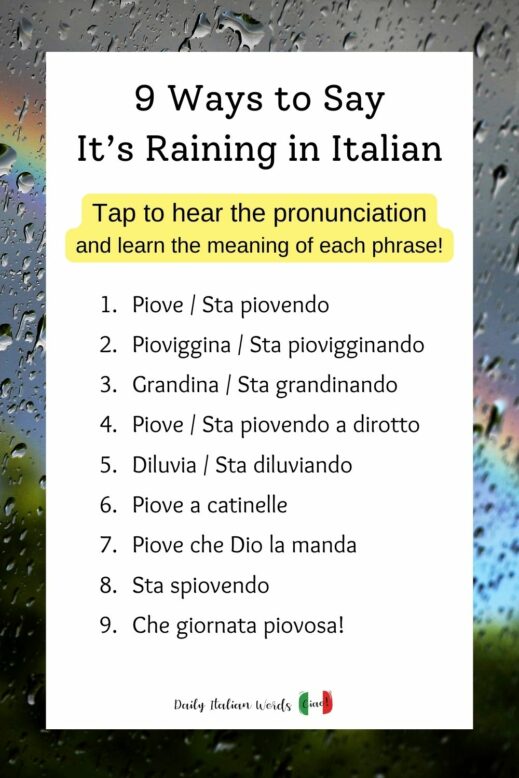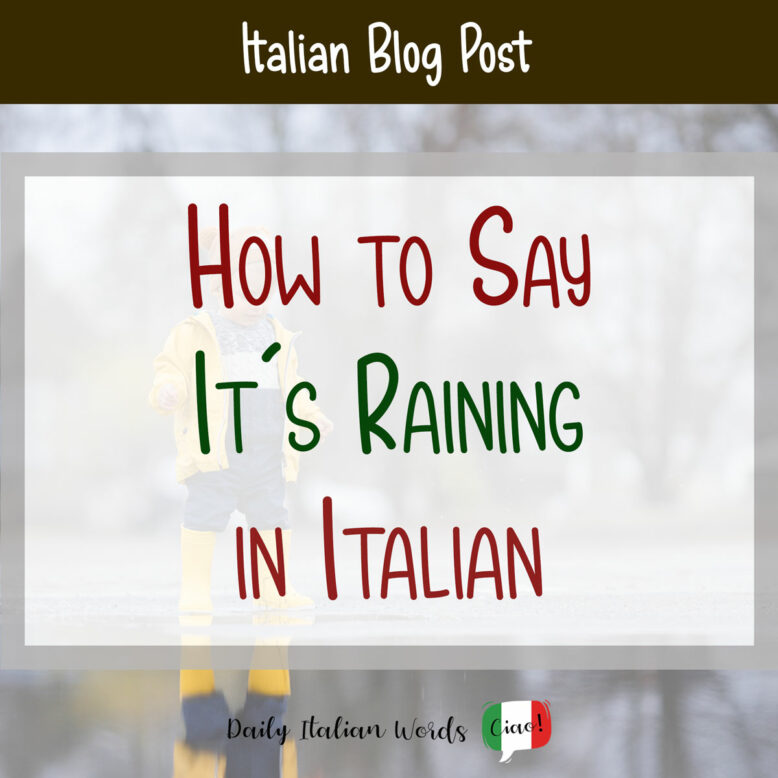It’s that time of the year when il tempo (the weather) often turns foggy and grey and la pioggia (the rain) makes its appearance, forcing us to seek shelter under un ombrello (an umbrella) or in the protective embrace of un impermeabile (a raincoat).
The previsioni del tempo (the weather forecast) may be our guide, but sometimes, all we need to do is gaze at the sky. Because remember, rule number one: cielo a pecorelle, pioggia a catinelle! If the sky is punctuated with fluffy white clouds resembling little sheep, you can bet your stivali di gomma (rubber boots) that la pioggia (the rain) is on its way. And when i fulmini (lighting) decides to light up the sky and i tuoni (thunder) starts roaring in the distance, brace yourself for a spectacular temporale (storm) that will fill the roads with pozzanghere (puddles)!
So, between gentle pioggerelline (drizzle) and dramatic acquazzoni (heavy showers), it’s helpful to familiarise yourself with the key ways for saying “it’s raining” in Italian so you’re well equipped for engaging in rainy conversations.

How to say “it’s raining” in Italian
Below you’ll find the most common expressions to talk about rainy weather in Italian. I’ve also included a couple of colloquial phrases in the mix to further enhance your conversational skills.
Piove / Sta piovendo
Piove is the most common way to say “it’s raining” in Italian. It’s in the third person singular and mostly use for general statements about the rain. However, if you wish to highlight that the rain is occurring at this very moment, it is more appropriate to use sta piovendo.
Piove sempre quando devo andare a un concerto all’aperto.
It always rains when I have an outdoor concert.
Non potete uscire a giocare, sta piovendo.
You can’t go out to play, it’s raining.

Pioviggina / Sta piovigginando
When it comes to describing a light rain or drizzle in Italian, the verb to use is piovigginare. Again, you must use it in the third person singular, hence pioviggina to convey a general state of drizzling and sta piovigginando to emphasise that the drizzle is happening right now.
Mi piace passeggiare quando pioviggina, lo trovo molto rilassante.
I enjoy taking a walk when it’s drizzling, I find it very relaxing.
Sta piovigginando, meglio prendere gli ombrelli.
It’s drizzling, better grab the umbrellas.
Grandina / Sta grandinando
When instead of gentle raindrops, there are ice cubes falling from the sky, then we say grandina (it hails) or sta grandinando (it’s hailing).
Ho sentito dire che sta grandinando in autostrada, meglio aspettare a metterci in viaggio.
I heard it’s hailing on the highway, better to wait before leaving.
Piove a dirotto / Sta piovendo a dirotto
To say that it’s pouring in Italian, we use piove a dirotto. This expression effectively communicates the idea that the rain is falling intensely.
La partita di calcio è stata annullata perché piove a dirotto.
The football match has been canceled because it’s pouring rain.

Diluvia / Sta diluviando
The Italian verb diluvia is similar to piove a dirotto. Translating to “it’s pouring” or “it’s raining heavily” in English, it perfectly captures the idea that the rain is coming down in large quantities and with considerable force.
Non riesco a vedere nulla, sta diluviando.
I can’t see anything, it’s pouring rain.
Piove a catinelle
The Italian expression piove a catinelle is used to describe a heavy and abundant downpour. Interestingly, while the English version suggests animals falling from the sky (“it’s raining cats and dogs”), in Italy we use the imagery of someone pouring buckets of water (from the word catino, meaning “basin”)!
Sei sicuro di voler uscire con questo tempo? Piove a catinelle!
Are you sure you want to go out in this weather? It’s raining buckets!
Piove che Dio la manda / Viene che Dio la manda
Among the various ways to express that it’s raining in Italian, there’s a playful option that attributes the responsibility for the inclement weather to none other than God! It’s not uncommon to hear Italians use expressions like “piove che Dio la manda” and “viene che Dio la manda,” both of which literally translate to “it’s raining as if sent by God” in English. This phrase is used when the rain is pouring heavily and is best suited for informal contexts.
Siamo arrivati al rifugio bagnati fradici, pioveva che Dio la mandava.
We arrived at the lodge completely wet; it was raining cats and dogs.
Oggi viene che Dio la manda, meglio restare in casa.
Today it’s raining cats and dogs, better to stay at home.

Sta spiovendo
When the rain is slowly coming to an end and the weather prepares to clear up, we say sta spiovendo in Italian. The verb spiovere perfectly captures the moment when the drops turn thinner and thinner, indicating the conclusion of the rainfall.
Guarda, sta spiovendo. Tra poco tornerà il sole.
Look, the rain is easing up. The sun will soon return.
Che giornata piovosa
Finally, not all rainy days are so unpleasant, right? Imagine being under the duvet on a Sunday morning, listening to the soothing pitter-patter of raindrops outside. Just take a deep breath and embrace the poetic charm, declaring in Italian Che giornata piovosa! (“What a rainy day!”).
Che giornata piovosa, è il tempo ideale per stare a letto con un buon libro.
What a rainy day, it’s the ideal weather to stay in bed with a good book.

Attention: the verbs seen above – piovere, piovigginare, grandinare – are impersonal (i.e. there’s no specific subject performing the action) and when talking about the past, they can be used with either the auxiliary essere or avere. For instance, both ieri è piovuto and ieri ha piovuto are correct expressions.
And now, remember, as the famous Italian writer Gianni Rodari would remind us, dopo la pioggia viene il sereno (“after the rain comes fine weather”). But until then, better to practice these phrases to announce that “it’s raining” in Italian!


Valentina Nicastro is a travel writer in love with her home country, Italy. Having travelled widely around the globe, she realised there was more to explore closer to home and decided to put the passport aside for a while. When she is not immersed in documenting Italy, you’ll find her donning her communication consultant hat, weaving words as a content writer and bridging linguistic divides as a translator.


